Before | 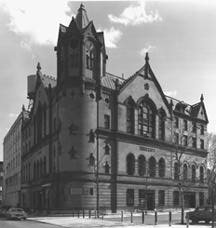 Harlem Courthouse at 121st St. & Sylvan Pl., between Lexington & 3rd Aves. | Before |
Female Inmates Stayed at Harlem Jail. | ||
Away from restored courtrooms... | Historic Harlem Courthouse comes alive again every Thursday as Small Claims litigants file papers and argue cases in a courtroom restored to some of the Romanesque Revival/Victorian Gothic building's grandeur from bygone eras. Restoration continues other days on a second courtroom, WPA murals and stairs with exquisitely intricate bannisters. | retouched WPA-painted murals...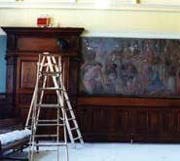 |
and redone bannisters...
| Not far from rejuvenated courtrooms and staircases are age-encrusted steps, dimly-lit corrirdors and a heavy metal door. Few people ever venture there. Just beyond that door beckon the empty cells of perhaps New York City's oldest complex of still-standing jail tiers. The tiered cells constituted the 5th District Jail operated by City Correction when Police Court began hearing cases in the five-story structure, circa 1892/93. The facility later played a role in reformers' struggle to have the city establish a special separate facility for women inmates. | are age-encrusted steps and... |
dim corridors where few venture.
| Male and female inmates had been housed separately within the same jails, but refomers urged that female inmates be lodged in entirely separate institutions significantly staffed by female personnel. They argued only such facilities could develope programs most suitable to female inmates' situations and needs. A blue-ribbon panel, the Page Commission, investigated. The resulting Page Law of 19l0/11 required providing special separate detention facilities. It set in motion site searches and design debates ending in the 1932 opening of the Women's House of Detention at Greenwich Ave. and 10th St. On the site had stood the Jefferson Market Prison, part of a court complex where, by the late 1920s, only cases with female defendants were heard. | There beckon empty cells...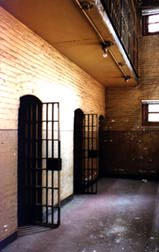 |
of perhaps NYC's oldest still-standing tiered jail.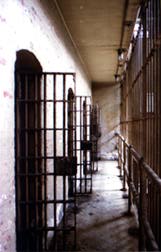 | Correction Commissioner Richard C. Patterson wrote in the 1931 annual report: "The prison at Harlem is being used temporarily as a House of Detention for Women. . . When the institution is abandoned for women, the Department may or may not, according to the state of its inmate census, use this institution for men. It is just as badly equipped as all the others (city detention prisons), but there is nothing that can be done about it under the circumstances. . . The women there now are of a class[ification] which formerly went to the old Jefferson Market Prison, but who had to be transferred when the new construction work made it necessary to tear the old building down." | It held women displaced from Jefferson Market Jail...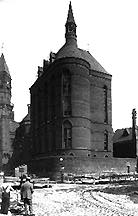 |
after Mayor Jimmy Walker, left, and Commissioner Patterson...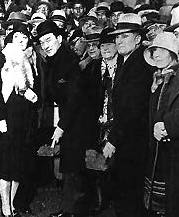 | Commissioner Patterson had questioned whether the Harlem jail would have any future after the Women's House opened. But, in fact, the Harlem detention cells continued to receive inmates for decades from 5th District Police Court, renamed Arrest and Summons Court. Later court reorganizations steadily diminished the old courthouse's role in the criminal justice system. Nevertheless, its Civil Court operations lasted until the early 1990s when a move by Small Claims Court to another location ended even that part-time judicial function. | broke ground on the site for the Women's House of Detention.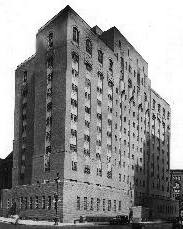 |
| The Sanitation and Air Pollution Control Departments had offices in the building for various units, but the City ceased housing any of its governmental agencies there after Small Claims Court moved out. Despite having attained landmark status in June, 1966, the structure fell victim to neglect and vandalism.
But in the last several years, restoration was begun and has been progressing under the Department of General Services, and now its successor agency, the Department of Citywide Administrative Services. Civil Court earlier this year resumed weekly Small Claims sessions, and various discussions are on-going for evolving and envolving other community uses. Now well into its second century, the old Harlem Courthouse still has a future yet to unfold. As for the Women's House of Detention that Commissioner Patterson hailed as "undoubtedly the best institution of its kind in the United States if not indeed in the entire world," it lasted only 40 years. The obsolete and overcrowded facility was shut down in the early 1970s, partly in response to Greenwich Village residents' protests about nightly shouting duets between the women behind bars and their men on the streets below. On June 18, 1971, Mayor John V. Lindsay and Correction Commissioner George F. McGrath officially opened the city Correctional Institution for Women on Rikers Island. Eventually that facility became the George Motchan Detention Center (for men) after the female inmates were moved in 1988 to another new structure built for them on Rikers, the Rose M. Singer Center (RMSC). The move was made to put available housing space to more efficient use consistent with inmate population needs and changes. | ||
| ||